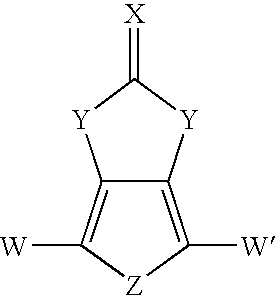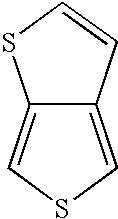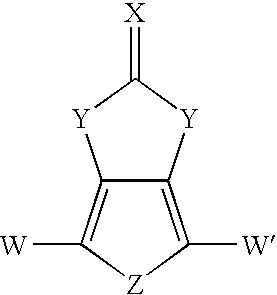Heterocyclic fused imidazolone, dioxolone, imidazolethione and dioxolethione monomers
a technology of imidazolethione and dioxolone, which is applied in the field of monomers for forming electrically conductive polymers, can solve the problems of difficult handling, storage and disposal of dangerous reaction chemicals, and achieve the effect of low band gap and high conductivity
- Summary
- Abstract
- Description
- Claims
- Application Information
AI Technical Summary
Benefits of technology
Problems solved by technology
Method used
Image
Examples
example 1
[0078]The compound 1H-thieno[3,4-d]imidazol-2(3H)-one was prepared in a single reaction mixture in accordance with the method of the present invention. In Example 1, triethylamine was utilized as a base to liberate 3,4-diaminothiophene from the dihydrochloride salt. Urea was used as the carbonyl containing second reactant compound.
[0079]An amount of 0.1922 gm (1.028×10−3 mole) 3,4-diaminothiophene dihydro-chloride (“DAT-HCl”) and 0.1866 gm (3.11×10−3 mole; 3.02 equiv., based on DAT-HCl) urea were added to a 50 mL three-necked flask equipped with magnetic stirring and a reflux condenser. The flask was purged with nitrogen for 15 minutes, after which 20 mL of 1,3-dimethyl-2-imidazolidinone (“DMI”) was added via syringe with stirring. The contents were warmed to 50° C., at which point 0.45 mL (0.327 gm, 3.23×10−3 mole; 3.14 equiv., based on DAT-HCl) triethylamine was added via syringe. The temperature of the flask was raised to 115-120° C. and maintained in that temperature range for 4...
example 2
[0082]1H-thieno[3,4-d]imidazol-2(3H)-one was prepared in a single reaction mixture in accordance with the method of the present invention. Example 2 uses an alternate base from Example 1, 4-(dimethylamino)-pyridine, as the base to liberate 3,4-diaminothiophene from the dihydrochloride salt. In addition, Example 2 utilizes 1,1′-carbonyldiimidazole as the second reactant compound.
[0083]An amount of 0.1934 gm (1.034×10−3 mole) 3,4-diaminothiophene dihydro-chloride (DAT-HCl), 0.4862 gm (3.001×10−3 mole; 2.90 equiv., based on DAT-HCl) 1,1′-carbonyldiimidazole, and 0.3957 gm (3.243×10−3 mole; 3.14 equiv., based on DAT-HCl) 4-(dimethylamino)pyridine were added to a 50 mL three-necked flask equipped with magnetic stirring and a reflux condenser. The flask was purged with nitrogen for 15 minutes, after which 20 mL of 1,3-dimethyl-2-imidazolidinone (DMI) was added via syringe with stirring. The temperature of the flask was raised to 115-120° C. and maintained in that temperature range for 4 h...
example 3
[0084]The compound 1H-thieno[3,4-d]imidazol-2(3H)-one was prepared in a single reaction mixture in accordance with the method of the present invention. Example 3 includes the use of sodium carbonate as the base to liberate 3,4-diaminothiophene from the dihydrochloride salt, and use of 1,1′-carbonyldiimidazole as the second reactant compound.
[0085]The procedure of Example 2 was followed with 0.1981 gm (1.059×10−3 mole) 3,4-diaminothiophene dihydrochloride (“DAT-HCl”), and use of 0.4868 gm (3.005×10−3 mole; 2.84 equiv., based on DAT-HCl) 1,1′-carbonyldiimidazole as the carbonyl containing reactant and 0.6591 gm (6.218×10−3 mole; 5.87 equiv., based on DAT-HCl) anhydrous sodium carbonate as the included base. After cooling and filtration, GC analysis showed complete conversion of 3,4-diaminothiophene; selectivity to 1H-thieno[3,4-d]imidazol-2(3H)-one was >98%.
PUM
| Property | Measurement | Unit |
|---|---|---|
| temperature | aaaaa | aaaaa |
| temperature | aaaaa | aaaaa |
| temperature | aaaaa | aaaaa |
Abstract
Description
Claims
Application Information
 Login to View More
Login to View More - R&D
- Intellectual Property
- Life Sciences
- Materials
- Tech Scout
- Unparalleled Data Quality
- Higher Quality Content
- 60% Fewer Hallucinations
Browse by: Latest US Patents, China's latest patents, Technical Efficacy Thesaurus, Application Domain, Technology Topic, Popular Technical Reports.
© 2025 PatSnap. All rights reserved.Legal|Privacy policy|Modern Slavery Act Transparency Statement|Sitemap|About US| Contact US: help@patsnap.com



